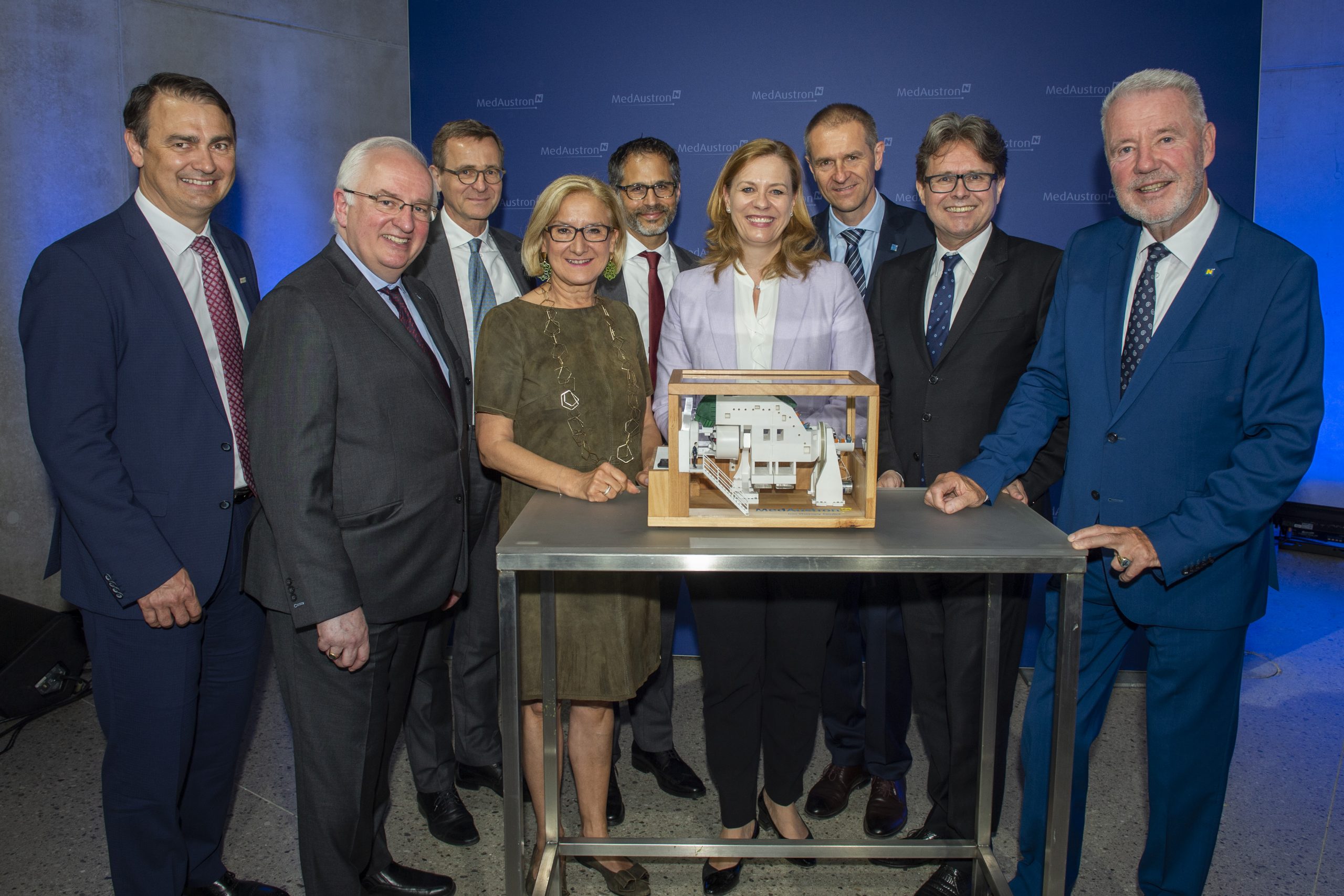“Next Level” of Cancer Therapy
At the Wiener Neustadt Cancer Treatment and Research Center, the third treatment room for patients was successfully put into operation – MedAustron is thus fully completed. This provided an opportunity to celebrate together with Governor Johanna Mikl-Leitner and domestic and international partners, and at the same time to take a look at the “next level” of cancer therapy.

“MedAustron is a project of hope that helps people regain their quality of life, and we are proud to have an internationally recognized center like this in Lower Austria. For a long time, research was a white spot in Lower Austria, but in the meantime we have a strong science axis with institutions such as, for example, Karl Landsteiner University, IST Austria or MedAustron. We also see it as a political mandate to bring science closer to the people, because after all they are the beneficiaries of research activities.”
“What has been created with the MedAustron center in a joint effort of the federal government, the province of Lower Austria and the city of Wiener Neustadt is exemplary. To date, there are only a few research and treatment centers of this kind in the world that compete on an equal level. This will strengthen Austria as a science location and make it even more attractive for research in this field.”
“The milestone – the completion of the last treatment room – is an emotional moment. After all, it took a lot of courage to establish the MedAustron project, it was a prime example of successful cooperation, and today I am very proud of what has already been achieved with the great team at MedAustron. I hope that particle therapy will continue to expand at MedAustron and that further development will ensure that we remain at the forefront of cancer therapy and research.”
The new treatment room is the third and last to be put into operation. Compared to those previously available, it features what is known as a gantry and thus the ability to direct the proton beam at tumors from different angles. What sounds seemingly simple and is common in conventional radiation therapy, however, requires a construction weighing about 220 tons in the case of particle therapy, which at the same time must work extremely precisely. A nine-meter-high rotating frame and several electromagnets weighing several tons to steer the charged particles form the gantry, which – unnoticed by those being treated – provides the new flexibility. The flexible beam application facilitates the optimal path to the tumor tissue and achieves optimal protection of healthy tissue, simplifies patient positioning in some cases, and will also make it possible to expand the treatment spectrum to include, for example, tumors in the thoracic and abdominal regions.
The management outlined which “next levels” can be expected at MedAustron in the coming years.
“The first years for MedAustron were characterized by introducing particle therapy in Austria and integrating it as a complementary method in Austrian oncology. Our goals for the future are to offer this high-precision therapy to even more patients, but also to achieve a quantitative increase by expanding our range of indications. The clear focus is on the expansion of carbon ion therapy, for which we also strongly rely on the cooperation with domestic and international partners.”
“MedAustron is in an excellent position. From now on, it is important to sharpen and expand our business areas Ion Therapy, Research & Development and International Projects. We want to strengthen the technical availability of our systems, intensify our partnerships, and also help build a center of excellence for cancer therapy.”
Alfred Zens, Chairman of the Lower Austrian Health Agency and former Managing Director of MedAustron, summarized milestones achieved. These included turning a machine designed for research into an effective, safe and the largest medical device certified in Europe to date, establishing a greenfield outpatient center and working with university partners to establish the center as a research facility as well.
Joachim Widder, Head of the University Department of Radiation Oncology and the Comprehensive Cancer Center at the Medical University of Vienna / AKH Vienna, classified particle therapy as a special further development of radiation therapy in the range of cancer therapies and explained what challenges medicine still has to overcome on the way to curing cancer. Many types of cancer are already curable, but multidisciplinary cooperation between all oncological disciplines will be needed in the future to increase the chances of cure for each patient in a highly individualized and precise manner.
Charlotte Warakaulle, Director for International Relations at the European particle physics laboratory CERN, spoke about the success factors for collaboration at the international level. MedAustron builds on CERN accelerator technology and is a successful example of the path from basic research to application and thus to direct benefit for people. This research is the driving force behind innovation in a wide range of technologies, and collaboration is, in a sense, the lifeblood of this.
International collaboration in the field of particle therapy was highlighted by Brad Hoppe, Professor of Radiation Oncology and Medical Director of Particle Therapy at Mayo Clinic Florida. In his keynote speech, he spoke primarily about the advantages of particle therapy with carbon ions, which – compared to that with protons – is still much less available, but offers a decisive advantage in the treatment of, for example, radiation-resistant tumors. The transfer of know-how from MedAustron is of great importance for the establishment of this form of therapy at the American center. Patients are to be treated with carbon ions in Florida from 2027, and the knowledge of local experts is therefore in great demand.
